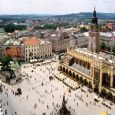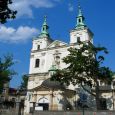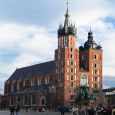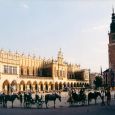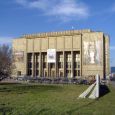Krakow
Advertisement
By plane
Krakow Airport (also known as John Paul II International Airport) (IATA: KRK, ICAO: EPKK) is the main airport, located in Balice, about 12km to the west of the centre. It is the second biggest airport in Poland.
The following airlines operate service to/from Krakow:
Aer Lingus (Dublin),Air Berlin (Berlin-Tegel),Austrian Airlines (Vienna),Brussels Airlines (Brussels),Czech Airlines (Prague),EasyJet (Belfast-International, Bristol, Edinburgh,Liverpool, London-Gatwick, Paris-Charles de Gaulle,Finnair(Helsinki),Germanwings (Stuttgart),Iceland Express (Reykjavik),
By train
Dworzec Glowny PKPis the central station in Krakow, and is located just outside of the Old Town. It is connected to other cities in Poland and the rest of Europe.
Every hour between 6 AM and 8 PM there is Express InterCity (EIC) train between Krakow and Warsaw with journey time of ~2h40. It is by far the most convenient way of traveling between Krakow and Warsaw. The ticket costs 110 PLN per adult. There is a discount of 37% (due to change to 50% from 2011) for students and anyone under 26 years. First class tickets are about 25% more expensive, and offer greater leg room. Few of these services throughout a day are classified as TLK which means they cost much less. If you are a desperate budget traveller you can also take an interregion train for 40 zł that takes 3 hours or the regular pospieszny train that takes over 5 hours, but costs 50 zł.
By car
The Polish government has completed the Autostrada A4 from the German border (Where it meets the Autobahn A4) to Krakow. This makes travel from the west fairly easy. The speed limit is generally 130 km/h (due to increase to 140 km/h from 2011), and there is a 16 PLN toll each way between Krakow and Katowice. Driving to or from Warsaw (300 km) is more difficult as the A1 has not yet been completed. The easiest route is the Route 7/E77 road, which should take less than five hours.
By bus
There are Europe-wide coach services operating into Krakow. However, it is cheaper and much quicker to fly, providing you book at least six weeks in advance. The journey time by coach from London, for example, is around 24 hours. It's pretty uncomfortable, and not recommended for anybody other than the desperate or enviornmentally conscious. A coach also leaves from Buchanan bus station in Glasgow city centre.
Within Poland, coach travel is not that much cheaper than going by train. However, it is much more awkward, and not recommended for traveling between cities. During the Summer, there are often services without air conditioning. Take plenty of water.
Advertisement
St. Mary's Basilica
St. Mary's Basilica, is a Brick Gothic church re-built in the 14th century (originally built in the early 13th century), adjacent to the Main Market Square in Krakow, Poland. Standing 80 m (262 ft) tall, it is particularly famous for its wooden altarpiece carved by Veit Stoss (Wit Stwosz).On every hour, a trumpet signal—called the Hejnal mariacki—is played from the top of the taller of St. Mary's two towers. The plaintive tune breaks off in mid-stream, to commemorate the famous 13th century trumpeter, who was shot in the throat while sounding the alarm before the Mongol attack on the city. The noon-time hejnał is heard across Poland and abroad broadcast live by the Polish national Radio 1 Station.
Main Market Square
The Main Market Square in Krakow is the most important market square of the Old Town in Krakow, Poland and a principal urban space located at the center of the city. It dates back to the 13th century, and – at roughly 40,000 m² (430,000 ft²) – it is the largest medieval town square in Europe
Sukiennice
The Renaissance Sukiennice is one of the city's most recognizable icons. It is the central feature of the Main Market Square in the Krakow Old Town (listed as the UNESCO World Heritage Site since 1978). It was once a major centre of international trade. Traveling merchants met there to discuss business and to barter. During its golden age in the 15th century, Sukiennice was the source of a variety of exotic imports from the East – spices, silk, leather and wax – while Krakow itself exported textiles, lead, and salt from the Wieliczka Salt Mine.
The Gothic Wawel Castle
The Gothic Wawel Castle in Cracow in Poland was built at the behest of Casimir III the Great and consists of a number of structures situated around the central courtyard. In the 14th century it was rebuilt by Jogaila and Jadwiga of Poland. Their reign saw the addition of the tower called the Hen's Foot (Kurza Stopka) and the Danish Tower.The Jadwiga and Jogaila Chamber, in which the sword Szczerbiec, was used in coronation ceremonies, is exhibited today and is another remnant of this period.Other structures were developed on the hill during that time as well, in order to serve as quarters for the numerous clergy, royal clerks and craftsmen. Defensive walls and towers such as Jordanka, Lubranka, Sandomierska, Tęczyńska, Szlachecka, Złodziejska and Panieńska were erected in the same period.
National Museum
The National Museum in Krakow, established in 1879, is the main branch of Poland's National Museum, which has many permanent collections around the country.Krakow National Museum was first housed at the upper floor of the Renaissance Sukiennice building, now the home of one of its many divisions. The construction of the Museum's New Main Building at 3 Maja Street started in 1934, but was interrupted by World War II. It was completed only in 1992.
Czartoryski Museum
The Czartoryski Museum and Library located in Krakow, Poland, was founded in Puławy in 1796 by Princess Izabela Czartoryska. The Puławy collections were partly destroyed after the November uprising of 1830–1831 and the subsequent confiscation of the Czartoryskis' property by the Russians. Most of the museum holdings, however, were saved and moved to Paris, where they reposed at the Hôtel Lambert. In 1870 Prince Władysław Czartoryski decided to move the collections to Krakow, where they arrived in 1876. The city was granted a degree of autonomy after the Austro-Hungarian Compromise of 1867.
St. Florian's Church
The Collegiate Church of St. Florian is a historic church in Krakow, Poland. It stands at the northern end of Matejko Square and the former centre of the mediaeval city of Kleparz, now a district of Krakow. The edifice marks the beginning of the Royal Road
Ojcow National Park
Ojcow National Park is a national park in Krakow County, Lesser Poland Voivodeship in southern Poland, established in 1956. It takes its name from the village of Ojcow, where it also has its headquarters.
Planty Park
Planty is a city park in Krakow, Poland. It encircles the District of Stare Miasto (Old Town), where the medieval city walls used to stand.The park has an area of 21,000 square metres (52 acres) and a length of 4 kilometers (2.5 miles). It consists of a chain of thirty smaller gardens designed in varied styles and adorned with numerous monuments and fountains. The park forms a scenic walkway popular with Cracovians. In summer, sprinkled with ponds and refreshment stalls, it is a cool and shady retreat from the nearby bustling streets
Jordan Park
Jordan Park, also known as Jordan's Garden or Park Jordana, was established in 1889 as the first public playground in Krakow, Poland, and the first of its kind in Europe. It was equipped with exercise fixtures modeled after those of similar playgrounds in the United States. The park is located in Krakow’s Błonia (municipal grasslands that had previously served as cattle pasture)
Information not available
Information not available
Advertisement

